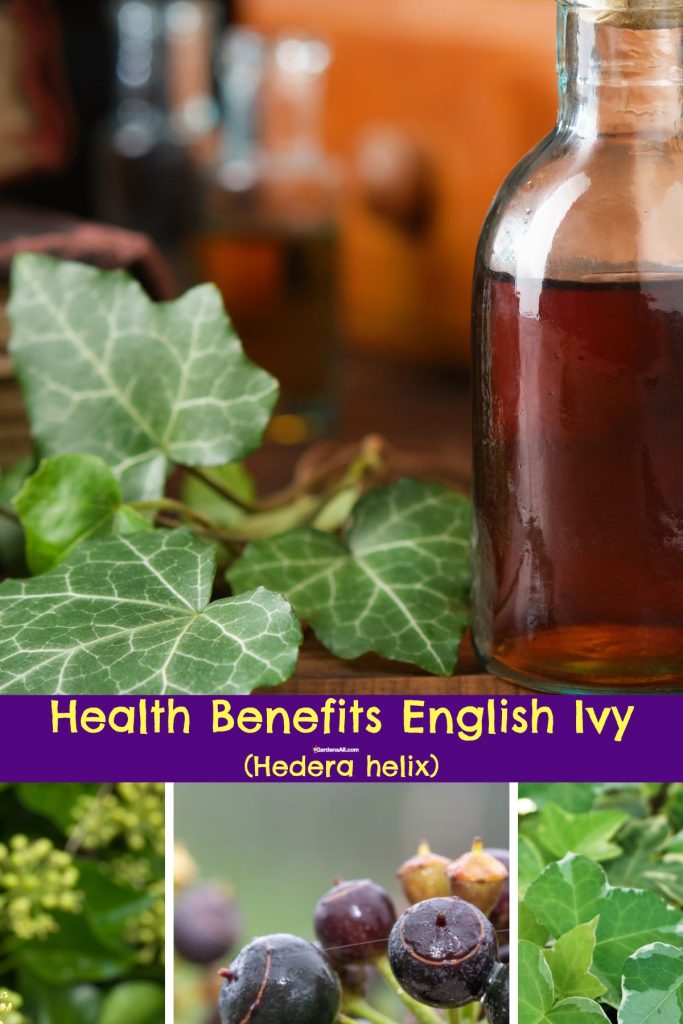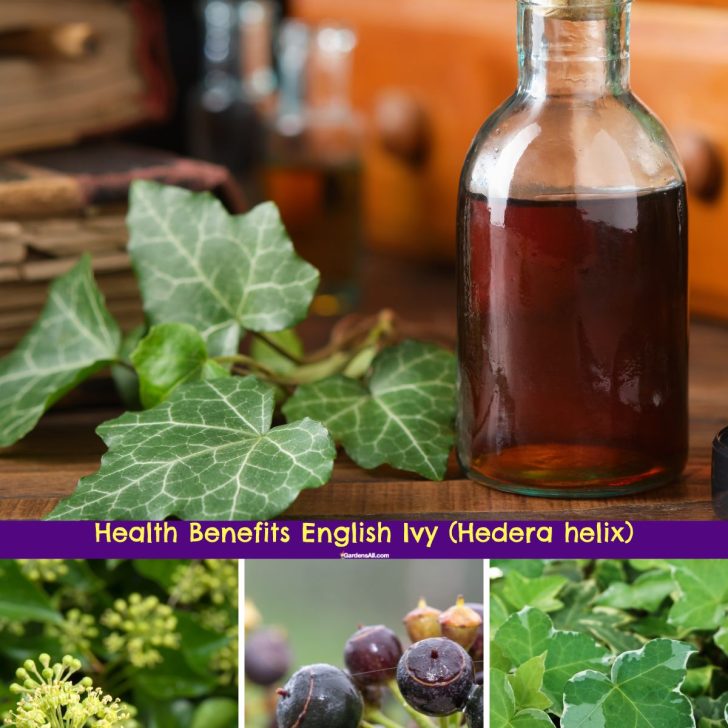We have tons of English ivy in the yard of our home of 33 years. Naturally, it has spread over time, as English ivy is wont to do. Many love it and others curse it for it can indeed be an invasive plant. However, no matter which side of this plant you’re on, it may be helpful to learn about the proven health benefits of English ivy, aka Hedera helix.
We enjoyed discovering more of the treasures this plant holds and hope you will as well.
Below here is a succinct list of some of the English ivy benefits. Below that is some expanded information along with footnotes of some of the scientific studies that showcase the proven health benefits of English ivy .
Health Benefits of English Ivy
What Parts of English Ivy Are Beneficial for Health
For medicinal purposes, both dried and fresh leaves of English Ivy (Hedera helix) can be used, depending on the specific application:
- Dried leaves are often utilized in the preparation of extracts and powders (usually in capsule form). Drying the leaves can concentrate their active compounds, making them more potent for use in herbal remedies and supplements.
- Fresh leaves might be used for making tinctures or extracts and can also be applied topically in some traditional remedies, although this is less common due to the potential for skin irritation from direct contact with the plant’s sap.
Regarding the use of Hedera helix berries, they are generally not recommended for medicinal use due to their toxicity. The berries contain glycoside hederin, among other compounds, which can be toxic if ingested, leading to symptoms such as nausea, vomiting, diarrhea, and abdominal pain. The primary focus of medicinal use of English Ivy is on the leaves due to their beneficial properties without the same level of toxicity associated with the berries.
List of Health Benefits of English Ivy, the Plant Parts Used and the Forms Involved
- Air Purification
- Part used: Leaves
- Form: Live plant for indoor air purification
- Allergen Reduction
- Part used: Leaves
- Form: Live plant to reduce airborne mold and allergens
- Antimicrobial Properties
- Part used: Leaves
- Form: Extracts and tinctures
- Respiratory Relief
- Part used: Leaves
- Form: Extracts used in cough syrups and lozenges for their expectorant properties
- Anti-inflammatory Benefits
- Part used: Leaves
- Form: Extracts, syrups and capsules for reducing inflammation, especially beneficial for respiratory conditions
- Antioxidant Benefits
- Part used: Leaves
- Form: Extracts and capsules to protect against oxidative stress and free radical damage
- Wound Healing
- Part used: Leaves
- Form: Extracts and capsules
Air Purification
A 1980 Clean Air Study conducted by NASA in the late 1980s, found that English Ivy is capable of absorbing toxins such as benzene, formaldehyde, xylene, and toluene from the air. These chemicals are common indoor pollutants, originating from household products and furniture. Other houseplants were also included in this study.[1]https://ntrs.nasa.gov/api/citations/19930073077/downloads/19930073077.pdf
- Part used: Leaves
- Form: Live plant for indoor air purification
Allergen Reduction
Research has also suggested that English Ivy can reduce airborne mold and allergens.
2005 Study at West Coast Clinical Trials, Long Beach, CA
A study conducted by Ryan Kim and co-author Hilary Spyers-Duran, a nurse practitioner and investigator at West Coast Clinical Trials in Long Beach, Calif., and published in the American College of Allergy, Asthma & Immunology in 2005.[2]https://www.healthday.com/health-news/allergies/could-a-house-plant-clean-the-air-529034.html
The researchers found that having English Ivy in the home reduced airborne fecal-matter particles and mold. The study findings were released in November, 2005 at the annual meeting of the American College of Allergy, Asthma and Immunology in Anaheim, Calif.
According to the study by Kim and Spyers-Duran, the plant reduced airborne particles of fecal matter by approximately 94 percent over 12 hours. The level of mold in the air went down by 78.5 percent in that same period of time.
While more studies are clearly needed, this is hopeful scientific evidence that plants such as English ivy do more than just beautify any indoor environment; they can also clear and purify it!
- Part used: Leaves
- Form: Live plant to reduce airborne mold and allergens
Antimicrobial Properties
English Ivy possesses antimicrobial properties, particularly against certain bacteria and fungi. This can be attributed to its saponins, compounds known for their ability to fight off pathogens. While more research is needed to fully understand the extent of these antimicrobial benefits, preliminary studies suggest that English Ivy could be a natural way to combat microbial growth in the home.[3]https://www.ncbi.nlm.nih.gov/pmc/articles/PMC9130539/
- Part used: Leaves
- Form: Extracts and tinctures
Anti-inflammatory Benefits of English Ivy
English Ivy’s polyphenolic saponins exhibits notable anti-inflammatory properties, making it a beneficial plant for reducing inflammation throughout the body. These properties are beneficial for most conditions that involve inflammation, and particularly advantageous for respiratory conditions.[4]https://www.ncbi.nlm.nih.gov/pmc/articles/PMC9130539/
- Part used: Leaves
- Form: Extracts and syrups for reducing inflammation, especially beneficial for respiratory conditions
Antioxidant Benefits of English Ivy
The antioxidant properties of English Ivy are also attributed to its high polyphenolic content and flavonoids. These antioxidants play a crucial role in protecting the body against oxidative stress and free radical damage, which are key factors in the development of chronic diseases such as cancer and heart disease.
By neutralizing free radicals, English Ivy helps to maintain cellular health, support the immune system, and potentially slow down the aging process.[5]https://www.ncbi.nlm.nih.gov/pmc/articles/PMC9130539/
- Part used: Leaves
- Form: Extracts and capsules to protect against oxidative stress and free radical damage
Wound Healing
Traditionally, English Ivy has been used in folk medicine for its wound-healing properties. Recent studies have begun to explore this benefit, finding that extracts from the plant can promote wound healing due to its anti-inflammatory and antimicrobial effects addressed above.
This suggests potential for English Ivy extracts to be used in topical treatments for cuts, burns, and other skin injuries.[6]https://www.ncbi.nlm.nih.gov/pmc/articles/PMC9130539/[7]https://new.nsf.gov/news/nanotechnology-sundew-english-ivy
- Part used: Leaves
- Form: Extracts and capsules may reduce inflammation which naturally aids wound healing, as well as the antimicrobial properties.
Respiratory Relief
English Ivy has been explored for its potential to provide relief from respiratory conditions, such as bronchitis, asthma, and coughs from colds. In one study, the extract of dry ivy leaves was shown to help children with bronchial asthma.[8]https://www.sciencedirect.com/science/article/abs/pii/S0944711304702196
The saponins in English Ivy can help to break down mucus and ease its expulsion, which may provide symptomatic relief for individuals with congested airways.
Some over-the-counter cough medicines and remedies include English Ivy extract for its expectorant properties.[9]https://www.ncbi.nlm.nih.gov/pmc/articles/PMC9130539/
- Part used: Leaves
- Form: Extracts used in cough syrups and lozenges for their expectorant properties
Caution and Considerations
While English Ivy offers several health benefits, it is important to approach its use with caution. The plant can be toxic if ingested, particularly for pets and small children, due to its glycoside hederin content.
Additionally, some individuals may experience skin irritation when handling the plant or allergic reactions to its pollen. More serious still is that those who are allergic to the compounds in Hedera helix have even experience anaphylaxis.
So if you do part choose to use English Ivy cough syrup or other remedies, it’s best to do a skin-patch test first, and if no reaction is noted, to proceed with caution. [10]https://pubmed.ncbi.nlm.nih.gov/24007931/
Conclusion
English Ivy is more than just an attractive vine; it holds a variety of health benefits, from purifying the air to offering antimicrobial properties and potential respiratory relief. As research continues, we may discover even more ways in which this versatile plant can contribute to health and well-being. Remember to proceed always proceed with informed caution.

You can find more general English ivy benefits and information here.
I’m LeAura Alderson, a garden, herb and plant enthusiast with a passion for discovering the many edible and medicinal benefits of the plants all around us, including the weeds! I’m a writer, editor and media publisher for our family of websites.
While I was certified in fitness and life coaching, I am NOT a health practitioner. However, I’m a lifelong health enthusiast, with a keen interest in healthy, organic foods and making home remedies and the content we share is from our own experience and usage as well as that extracted from scientific research so that you can explore further on your own.
Always seek the advice and guidance of your health practitioners first and foremost.
As a family we’re steadily expanding our gardening, experimentation and knowledge around all things gardening, edible landscaping, fresh organic foods and self sustainability with farming in our future. I also own and manage iCreateDaily.com, a site all about transformation through creation, and the power of positivity, optimism and mindset.
References

